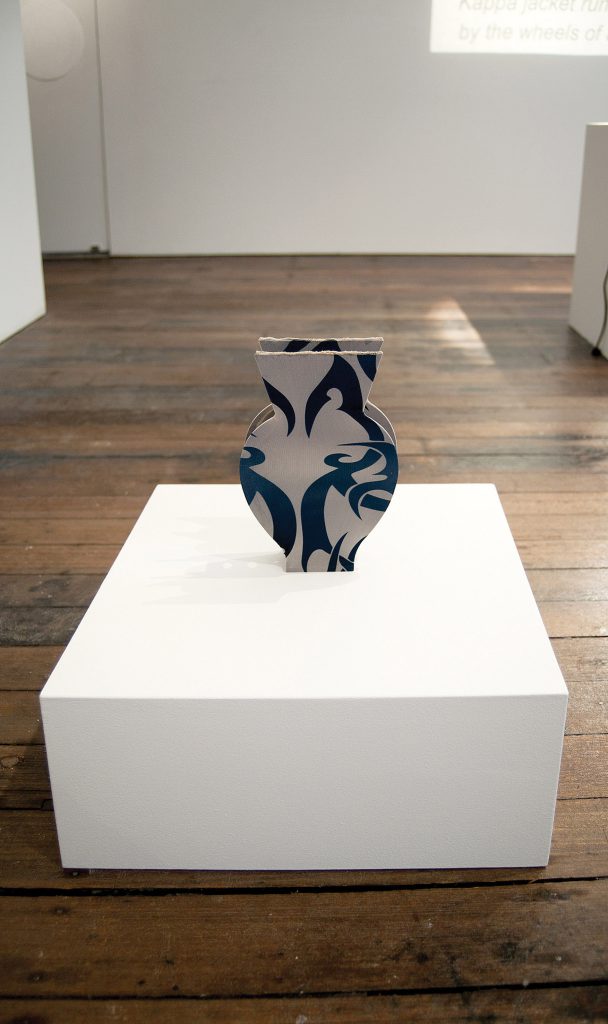
Torso akin to vase (wear flowing or fitting shirts), whatever etc 2012
tribal arm stockings, plywood
Image courtesy the artist and Craft Victoria
Photo credit: Lily Feng
—
Alex Vivian
Men’s Apparel, distressed
Craft Victoria, Melbourne
8 March – 21 April 2012
In the myth of Pygmalion, a Cypriot sculptor falls in love with the realism of his own statue of a female figure after previously being unable to find attraction in women. His abstracted object of desire is manifested in the idyllic sculpture that he creates. The situation is rendered terrible when upon touching the statue the sculptor is faced with the cold marble becoming the monstrous reality of warm bodily flesh — the sculptor’s object becomes subject. That which transforms the statue varies in different accounts of the story, but is often cited as a transformative kiss. This detail may seem soft-core when considering the sculptor’s touch — relying on the physical action of the man upon his desired object — the transformative Thing that gives life to the statue is both an act and a stain.
Perhaps similar to the sculptor’s studio, the teenage male transforms his bedroom from childhood utility into a stage for phantasmal creation — a place to pin up inspirations and go to work. A slave to process, he discards the objects that bear the stain of his own creation: socks ’n’ jocks, post-jog trainers, alternative hairstyles, blu-tacked posters and skateboard magazines — masturbatory activities, and their cause and affect.
It is the sublimation of the above allegories that may be apparent in Alex Vivian’s Men’s Apparel, distressed; a post-punk, post-fuck aesthetic that unifies vases, soccer jerseys and tube socks in an anarchistic ikebana-styled arrangement of domestic objects come neoclassical pastiche. Like the Cypriot sculptor, it is the stain that acts as the transformative Thing in Vivian’s work — domestic objects become subjective art objects, physically altered and laden with metaphorical ballast, recalling the mundane and monstrous effect often present in the work of Mike Kelley. Indeed, like Kelley, Vivian’s work constantly refers back to the body as a muse: a place of both creation and marketable filth.
Men’s Apparel, distressed is Vivian’s second solo show in Melbourne that designates his work to the formalism of white museum plinths.1 Atop of their pedestals, Vivian’s works are divorced from process and displayed in the marketable habitat of design. Here, Vivian’s forms are given the space to punctuate their singularities — odd menageries of consumer objects oozing a perverse libidinal aura upon their sterile context. Notably, in Vivian’s Torso akin to vase (wear flowing or fitting shirts, whatever etc) 2012, a vase shaped from plywood has been dressed in an arm-stocking printed with tribal tattoos. The classical trope of the vase is in constant tension with its perverse faux skin. In this case, the print acts as a stain, the excess or, rather, the güero that activates Vivian’s objects, enabling them to transgress their own domesticity.2
The libido in Vivian’s materials results in a type of a jamming between form and function: vessels soiled by tube socks that have been inserted into their cavities — the socks themselves perhaps a monument to male libido (think socks on cocks/tube sock as Kleenex) that find their place as apt metaphors for bodily traces. Just as the tribal pattern recalls specific cultural weight, references to Dada Jeans and Kappa Jackets in Vivian’s projected poem Distressed clothing (ideas towards) 2012 illustrate how the artist is approaching a sculpturally poetic practice drawing from the perceived ‘cultural wasteland’ of Australian suburbia.3 The manifestation of Vivian’s ad-hoc Windows PC poetry as a Xerox copy on office-grade acetate, typeset in italicised Arial and beaming from a classroom overhead projector further speaks to the language of information-age-suburban-DIY. A clever, elastic treatment is applied to the word ‘Dada’, where it is both signifier of the 1990s hip-hop brand name and its historical framing via a Tzara-ian word poem.
The ways in which Vivian stages minor insurrections between cultural signifiers, form and context feels comfortable, intelligent and approachable and it is communicated through an understanding of small scale sculpture and informed by an ongoing engagement with installation in his practice. The process for the creation of these works may seem invisible at first glance, but from atop of their plinths, Vivian’s sculptures recall a primal scene — the stuffing, sweating, and staining of fashion, form and phallus coerced with classical elegance — expropriated semaphores that signal transgressive suburban youth.
Nicholas Tammens is an artist.
